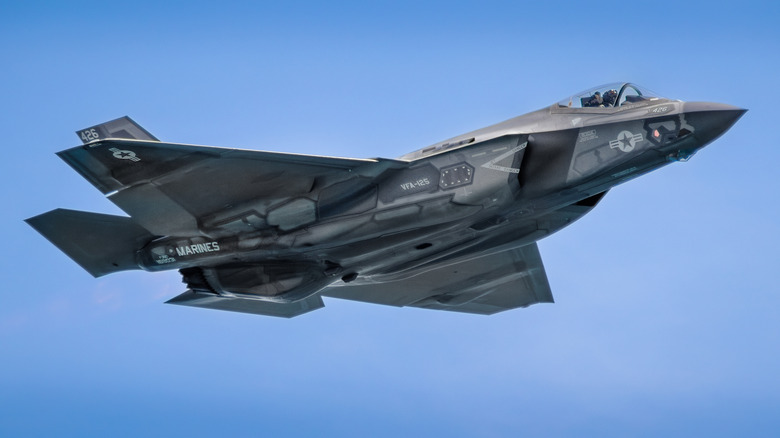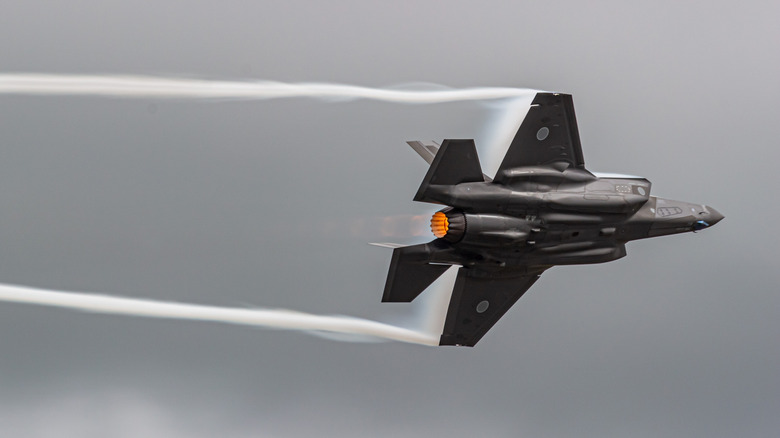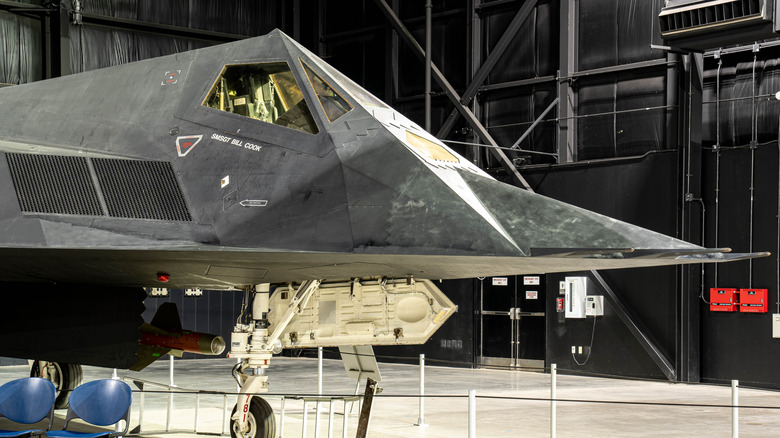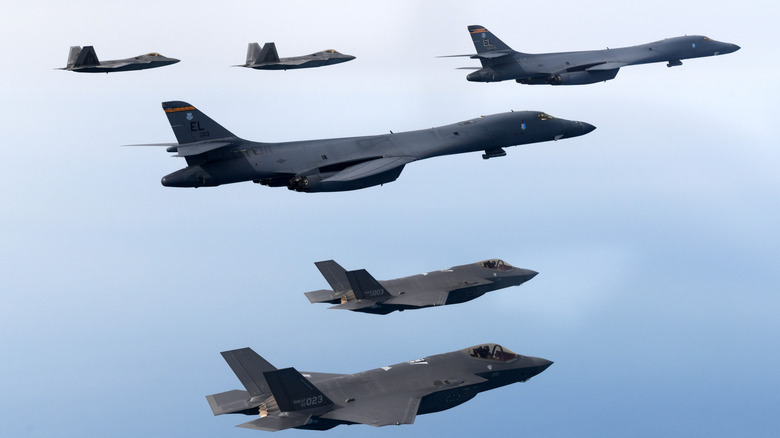China Claims It Can Track An F-35 Stealth Fighter, But It's Not The Jet It's Spotting
The F-35 is a fearsome jet with outrageous capabilities. This makes it a threat that powers around the world have had to pay attention to, whether they want it in their ranks or they seek a way to counter it. In attempting to do the latter, the difficulty is trying to track it, because as creator Lockheed Martin boasts, it was "made to evade." This is reflected in everything from its sophisticated sensors to the way it stores fuel, from the unique signal-dampening paint on its body to the angle of its components.
While all of this is true, there's no way to make even the stealthiest jets completely invisible and undetectable. China claims that technology using its BeiDou satellite system will allow it to track the likes of the F-35, primarily through one of the very characteristics that such models aim to minimize: Their tell-tail exhaust plumes. The BeiDou technology may even be able to turn such a stealth fighter's ability to distort and muddle incoming signals against it, by determining the position of the disturbance and so putting together a picture of the aircraft that could be hidden there. The South China Morning Post stated in February 2025 that such technology has enormous potential. According to the newspaper, Changchun Institute of Optics, Fine Mechanics and Physics scientists utilized an "unmanned airship hovering at 20km ... deploying mercury-cadmium-telluride detectors and 300mm aperture telescopes" and could 'see' an F-35 from over 1,110 miles away. That is, it could see the considerable heat signature of the aircraft.
China's BeiDou system and its potential anti-stealth utility
BeiDou, named for the Big Dipper constellation, is an advanced Chinese satellite system. It has grown to a network of some 45 satellites, combining high Earth orbit and medium Earth orbit satellites, with low Earth orbit additions set to be added to the mix before the latest generation of the system is completed in approximately 2035. Over a decade ago, BeiDou could provide focused coverage on Asia Pacific, but has now developed to the point that it covers the whole Earth.
It goes without saying that the ability to track models like the F-35, one of the most sophisticated stealth fighters in the world, would indeed be a huge boon. One aspect of doing this is the fact that a fighter jet's exhaust can emit an awful lot of heat, with the engine's combustor heating its all-important air up to around 3000 degrees. The South China Morning Post reports that the study cited in February 2025 concluded, "while the jet's radar-absorbing coating and exterior cooled to an average 281 degrees Kelvin (7.85 degrees Celsius or 46 Fahrenheit) ... its engine exhaust plume, which reaches nearly 1,000 Kelvin, emitted mid-wave infrared radiation three orders of magnitude stronger than its airframe." Makers of stealth aircraft are entirely aware of the importance of trying to minimize this key 'weakness' in such an aircraft's design. Keeping the fuel internal and carefully positioning the engine reduces both the noise it makes and the heat emitted, while other models might boast unique engine architecture to cool that air as it does its job. Even so, that plume is still a danger.
Decoding refracted signals
Stealth aircraft also confuse the radar signals that seek to detect them. Through means such as unique coatings that prevent the signals from bouncing back, and by reflecting them away using the unusual angles of the aircraft's body, as with some stealth bombers, the goal is the same: To prevent operators from knowing exactly what's flying and where it's going. What if they could interpret the confused signals left behind, though? According to reports, this is part of what the new technology can do. According to The Eurasian Times, "with the use of BeiDou signals, the radar can detect refraction patterns caused by stealth aircraft. These patterns create unique echoes, allowing scientists to estimate the type and location of the aircraft." The concept, then, makes a primary asset of a stealth aircraft into something of a potential liability. Even the supposedly invisible classic that is the F-117 Nighthawk (pictured here) can be detected somehow.
In another instance shared by the South China Morning Post in September 2024, a DJI Phantom 4 Pro operated by researchers in Guangdong was "illuminated by electromagnetic radiations emitted by a Starlink satellite flying over the Philippines, according to the scientists." What's most notable about this is that the interaction with the satellite gave the stealthy drone's position away to radar, without any radar signals being active. It's possible, by extension, that a fighter jet like the F-35 could be tracked in a similar fashion. The implications of this are so severe that Logan Kygler, writing for Communications of the ACM, questioned whether the discovery could potentially mean "The end of stealth," though given that "normal atmospheric phenomena or normal planes can produce the same effect," a lot of refinement would seem necessary before regular use in such a capacity.
A comparison to other radar systems
Minimizing an aircraft's visibility to radar has been a critical concern of warfare since World War II, so the idea of detecting others' aircraft while concealing one's own is hardly anything new. The important aspect of this development in particular is how it may differ from the sophisticated radar that nations around the world already use.If the early reports are to be believed, the Chinese system seems to be set apart by its relative simplicity and inexpensive nature. This could result in a program that is both cheaper to run and more effective to use than more 'sophisticated' contemporary alternatives. Another advantage is that it doesn't use conventional radar signals, but instead information gathered and analyzed by the BeiDou satellite network. Factor in the supposed difficulty of detecting where it's operating from, as well as its ability to use other GPS signals should BeiDou be compromised, and there are a lot of advantages to the tech.
It's also vital to remember, though, that there is a lot that's still unknown about this development. This is unsurprising as China is also known to be protective of its own stealth models, having banned export of its J-20 stealth fighter early in 2025. It also has significant caveats and shortcomings. Though the South China Morning Post noted that the report claimed to detect an F-35 from a tremendous distance using the radar, it also went on to state that the 1,110+ mile range was only possible at certain angles: "detection from the front remained limited to 350km [approximately 217.5 miles] because of the stealth jet's reduced forward heat profile."



